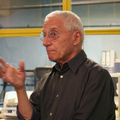Atelier Mendini
— interview with Alessandro and Francesco Mendini
About
The studio "Atelier Mendini" opened in Milan in 1989. Here, Alessandro joined brother Francesco Mendini to take on projects such as a memorial tower in Hiroshima, Japan; the Groninger Museum in Holland, the Arosa Casino in Switzerland, and many others. The studio itself employs 25 architects, designers, and graphic artists. Experimental design is common place, as well as commercial projects.
Alessandro Mendini was born in Milano in 1931. He then became a partner at Nizzoli Associati Practi until 1970. Later, he founded the design school "Global Tools". In the 1970s and 80s, Alessandro became heavily involved in the theoretical side of design, becoming the editor-in-chief of Casabella, Modo, and Domus. After, he founded the Alchimia design studio, a time during which he focused on neo modern and contemporary design. His work centers on making objects, furniture, interiors, and installations. Most of his work is collaborative, involving many other designers from many locations, including Alessi, Phillips, Swatch, and others. He is also the creative director for Swatch. He is a winner of the "compasso d'oro" for excellence in design. His work is present around the world, both in architecture and in museums.
Architect Francesco Mendini was born in Milano in 1939. He began his professional career in the studio of Nizzoli Associati, producing architectural designs for customers in Europe and Africa. In the 1970s he shifted his focus to structural engineering of architectural projects. He serves as a consultant for a number of institutions that experiment with new building materials. Within the Atelier Mendini, he is responsible for architectural projects.
— Referenced from http://www.ateliermendini.it — http://www.designboom.com — http://www.culture.plInterview Ideas
- Working in competitions allows freedom, while working with physical construction is very specific.
- The real power in Italy is in academia, yet there is less opportunity in this area for young designers/architects.
- Italy is the only place in Europe that exhibits a unique structure of geographic mapping between the North and the South.
- The degree of marketing importance affects the outcome of the work.
- Italy is highly political, so young firms find more opportunities to do competitions internationally.
Video/Key Quotes
- Modern Design Schools

- Is there still a place for the Botega?

- Other Design Schools

- Collaborative Design Processes

- The Early Years

- What Italians Think of "Italian Design"

- The Best Designers

What We Learned
We left the Mendini interview feeling as though the process had just begun; we were in awe. While the interview had been brief, Alessandro and Francesco Mendini gave us the chance to see clearly into the world in which they design, and how they think. Through years of reflective practice and successive iterations of improving products, architecture, and furniture, the Mendinis’ reinforced the message that Italian design is different because of many factors. This was one of many interviews that commented on the poor state of design education in Italy. The schools are no longer producing the world's top designers as they once did. In fact, the schools were only really created in the first place because of the wave of leading Italian designers. If the schools never created the best, how will they now? Too many of the architecture and design schools in Italy are too large and too bureaucratic. The Mendini's believe that the modern architecture studio is today's version of the traditional Italian botega, where a student learns the craft from a master. More examples of these studios should help the Italian design industry strengthen itself in the future.
The Mendini's believe strongly in the idea of collaboration with other designers. They believe having people working with them from different backgrounds and places yields interesting perspectives in design. For example, they are working on metro stations in Napoli (Naples), where they invited 15 leading architects to design parts of each station. This process of collaboration has yielded new results and different ideas for the stations than they could have thought of on their own.
In terms of globalization, the Mendini's taught us that the work everywhere is quite similar, but it is the people that make it unique.
